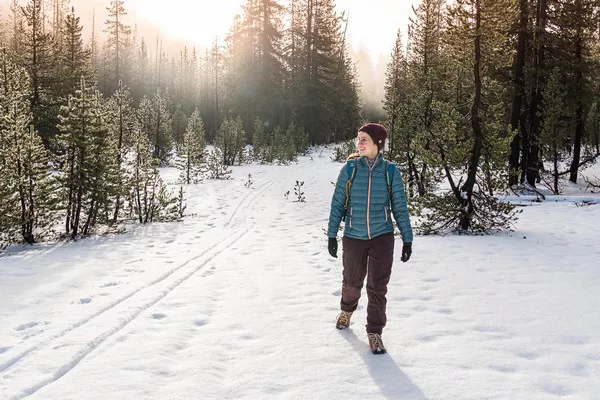As winter blankets the landscape with its icy grip, many outdoor enthusiasts find themselves drawn to the serene beauty of snow-covered trails. However, venturing into the winter wilderness requires more than just enthusiasm; it demands careful preparation, especially when it comes to choosing the right attire. The cold, wind, and snow pose unique challenges that must be met with appropriate clothing to ensure both comfort and safety on the trail.
Understanding the Elements: Key Considerations
Before embarking on a winter hike, it’s crucial to understand the environmental factors that will influence your choice of clothing. Here are some key considerations to keep in mind:
1. Temperature: Winter temperatures can vary widely depending on location and elevation. Be prepared for fluctuating temperatures and dress in layers to regulate your body heat effectively.
2. Wind: Wind chill can significantly lower the perceived temperature, making it feel much colder than the actual temperature reading. Windproof layers are essential to protect against wind chill and prevent heat loss.
3. Moisture: Snow, sleet, and freezing rain are common winter precipitation types that can soak through clothing and lead to hypothermia. Choosing moisture-wicking and waterproof materials will help keep you dry and comfortable throughout your hike.
4. Terrain: Consider the terrain you’ll be hiking on. Snow-covered trails may require specialized footwear for traction, while rocky or icy terrain demands sturdy, ankle-supporting boots.
The Layering Strategy: Building Your Winter Hiking Ensemble
Layering is the cornerstone of winter hiking attire, allowing you to adjust your clothing to changing weather conditions and activity levels. A well-designed layering system typically consists of three main layers:
1. Base Layer: The base layer is in direct contact with your skin and is responsible for moisture management and insulation. Opt for moisture-wicking fabrics such as merino wool or synthetic materials like polyester or nylon. These materials will wick sweat away from your skin, keeping you dry and comfortable.
2. Insulating Layer: The insulating layer provides warmth by trapping heat close to your body. Common insulating materials include fleece, down, or synthetic insulation such as PrimaLoft. Choose an insulating layer with enough loft to provide warmth without adding too much bulk.
3. Outer Shell: The outer shell serves as your first line of defense against wind, snow, and rain. Look for a waterproof and windproof jacket and pants made from breathable materials to prevent overheating and moisture buildup. Features like adjustable hoods, pit zips, and reinforced knees and elbows can enhance comfort and functionality.
Head-to-Toe Protection: Essential Gear for Winter Hiking
In addition to the three-layer clothing system, several other pieces of gear are essential for winter hiking:
1. Headwear: A warm hat or beanie that covers your ears is crucial for retaining heat, as a significant amount of body heat is lost through the head. Consider wearing a balaclava or neck gaiter for added face and neck protection in extreme cold.
2. Gloves or Mittens: Protect your hands from frostbite with insulated gloves or mittens. Look for gloves with waterproof and windproof exteriors and removable liners for added versatility.
3. Footwear: Choose insulated, waterproof boots with good traction to navigate snow and ice safely. Consider wearing gaiters to prevent snow from entering your boots and to provide an extra layer of protection against cold and moisture.
4. Socks: Opt for moisture-wicking, thermal socks made from materials like merino wool or synthetic blends. Avoid cotton socks, as they retain moisture and can lead to cold, damp feet.
5. Accessories: Don’t forget essential accessories like sunglasses or goggles to protect your eyes from snow glare, as well as a sturdy backpack to carry extra layers, water, snacks, and emergency supplies.
Fine-Tuning Your Attire: Tips for a Successful Winter Hike
Check the Weather: Stay informed about current and forecasted weather conditions for your hiking destination. Plan your attire accordingly and be prepared to adjust your layers as needed.
1. Practice Proper Hydration and Nutrition: Stay hydrated by drinking plenty of water, even in cold weather when you may not feel as thirsty. Pack high-energy snacks like nuts, dried fruit, and energy bars to fuel your hike and maintain body heat.
2. Monitor Your Body Temperature: Pay attention to how your body feels throughout the hike. If you start to feel too warm or too cold, adjust your layers accordingly to prevent overheating or hypothermia.
3. Stay Dry: Minimize sweat buildup by regulating your body temperature with appropriate layering and ventilation. Remove layers promptly if you start to sweat and avoid cotton clothing, which retains moisture.
4. Be Prepared for Emergencies: Pack essential emergency supplies such as a first aid kit, emergency blanket, fire starter, and navigation tools. Let someone know your hiking plans and expected return time, and carry a fully charged cell phone for communication in case of emergencies.
Conclusion
Winter hiking offers a unique opportunity to experience the natural beauty of snowy landscapes while enjoying solitude and tranquility on the trail. However, it also presents challenges that require careful preparation and the right attire. By understanding the elements, layering strategically, and equipping yourself with essential gear, you can stay comfortable, safe, and prepared for whatever winter may bring on your outdoor adventures. So, bundle up, lace up your boots, and embrace the wonders of winter hiking with confidence and enthusiasm.

